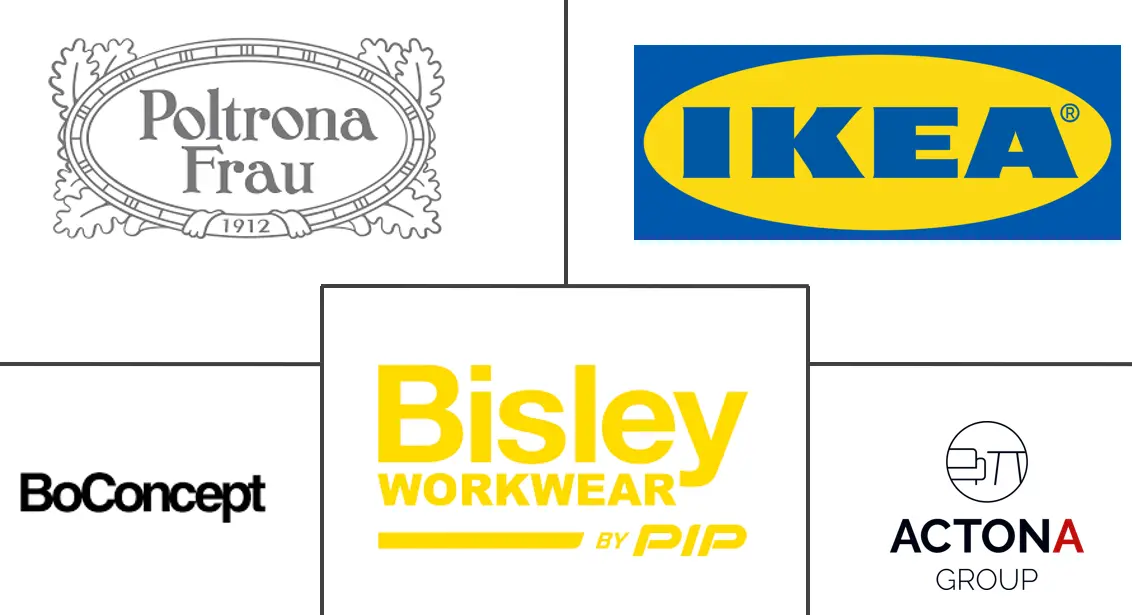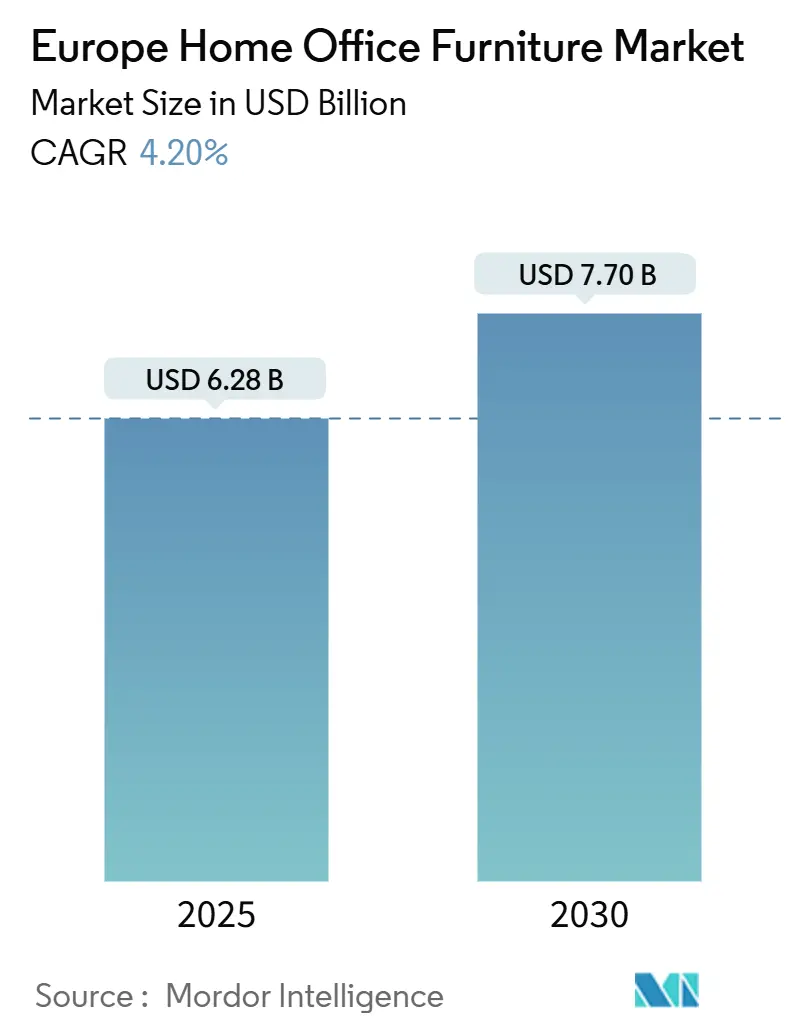
Europe Home Office Furniture Market Analysis by Mordor Intelligence
The Europe Home Office Furniture market, valued at USD 6.28 billion in 2025, is expected to reach USD 7.70 billion by 2030 at a 4.20% CAGR as hybrid work arrangements become a structural feature of European labor markets. This growth trajectory reflects the market's resilience despite economic headwinds, as hybrid work policies become institutionalized across European corporations. The market's evolution is characterized by a fundamental shift from reactive pandemic-driven purchases to strategic investments in ergonomic, sustainable, and technology-integrated solutions. Raw-material volatility, particularly for wood and steel, continues to squeeze margins; nevertheless, suppliers are mitigating risk by diversifying into composite or recycled inputs that satisfy the EU Deforestation Regulation. Competitive dynamics therefore present a bifurcation: large multinationals rely on scale and vertical integration, whereas smaller specialists secure share through sustainability, niche aesthetics, and superior service.
Key Report Takeaways
• By product type, office chairs commanded 41% of the 2024 revenue of the Europe home office furniture market and are projected to advance at a 4.7 % CAGR through 2030.
• By material, wood led with a 45% market share in 2024, while plastic & polymer options are expected to post the fastest growth at a 5.5% CAGR to 2030.
• By price range, mid-range models accounted for 40% of sales in 2024, whereas the Europe home office furniture market for premium offerings is forecast to expand at a 5.2% CAGR over the same period.
• By distribution channel, specialty stores captured 38% of 2024 turnover, yet online sales are set to rise at a 7.3 % CAGR through 2030.
• By geography, Germany contributed the largest slice with a 22% share in 2024, and Spain is on track for the quickest growth at a 5.1 % CAGR toward 2030.
Europe Home Office Furniture Market Trends and Insights
Drivers Impact Analysis
| Drivers | (~) % Impact on CAGR Forecast | Geographic Relevance | Impact Timeline |
|---|---|---|---|
| Proliferation of Hybrid-Work Policies | +1.2% | Pan-European, with the highest impact in the UK, Germany, Nordics | Medium term (≈3-4 yrs) |
| Technological Advancements and Smart Furniture | +0.8% | Western Europe, the Nordics | Long term (≥5 yrs) |
| E-commerce Furniture Sales Growth | +1.0% | Pan-European, with the highest impact in the UK, Germany, and France | Short term (≤2 yrs) |
| FSC/PEFC-Certified Sustainable Furniture | +0.6% | Nordics, Germany, France, Netherlands | Medium term (≈3-4 yrs) |
| Urban Downsizing & Space-Saving Solutions | +0.7% | Major European metropolitan areas | Medium term (≈3-4 yrs) |
| Source: Mordor Intelligence | |||
Proliferation of Hybrid-Work Policies Across Europe
Hybrid arrangements are now entrenched, with Haworth reporting that 84% of the global organizations formalize flexible work policies.[1]Haworth, “Hybrid Work Insights From Our Global Customers,” Haworth, haworth.com The United Kingdom leads adoption, while France lags, producing a patchwork of demand intensity that mirrors national labor norms. Manufacturers learn that where policies are contractual, households willingly invest in permanent ergonomic furniture; where flexible work is informal, ad-hoc spending prevails. This divergence explains why volume spikes first appear in markets such as the DACH region shortly after legislation clarifies employee entitlements to remote work.
Technological Advancements and Smart Furniture Integration
Smart ecosystems have moved beyond USB hubs; height-adjustable desks now schedule elevation shifts automatically in response to usage analytics gleaned from embedded sensors. Chairs send posture prompts to smartphone apps, transforming static furniture into active wellness companions. Interoperability with mainstream voice assistants is fast becoming a differentiator because buyers reject closed systems that clutter their smart-home routines. The convergence of data, furniture, and health metrics is steadily redefining perceived product value.
Rapid Growth of E-commerce Furniture Sales Across Europe
Online revenues grow almost twice as fast as the overall Europe Home Office Furniture industry, as immersive visualization dissolves reluctance to buy bulky items sight unseen. Shoppers expect glitch-free configurators, real-time inventory, and delivery slots at checkout; any digital friction diverts them back to in-store channels. Retailers counter by blending physical showrooms with virtual planning suites that allow customers to finalize purchases after tactile validation. Faster digital adoption also shortens product life cycles because online marketing can surface trends before competitors replicate them.
Rising Consumer Preference for FSC/PEFC-Certified Sustainable Furniture
Environmental credentials have become a baseline requirement, and companies that cannot verify chain-of-custody risk exclusion from retailer assortments. IKEA’s decision to use 99.5 % certified or recycled wood underscores how scale players absorb certification costs while turning compliance into brand equity.[2]Forest Stewardship Council, “Furniture,” Forest Stewardship Council, fsc.org Source: Nordic Swan Ecolabel, “Furniture and Fitments - Criteria Document,” Nordic Swan Ecolabel, nordic-swan-ecolabel.org Early adopters of sustainable sourcing gain a head start in navigating the EU Deforestation Regulation, making future procurement smoother and cheaper than for late entrants. Circular business models, such as corporate buy-back schemes, further extend product life and generate secondary revenue streams.
Restraints Impact Analysis
| Restraints | (~) % Impact on CAGR Forecast | Geographic Relevance | Impact Timeline |
|---|---|---|---|
| Volatile Raw-Material Prices | -0.5% | Pan-European, with the highest impact on Eastern European manufacturers | Short term (≤2 yrs) |
| Eurozone Inflation | -0.9% | Southern Europe, Eastern Europe | Short term (≤2 yrs) |
| Second-Hand & Furniture-Rental Platforms | -0.7% | Western Europe, the Nordics | Long term (≥5 yrs) |
| Source: Mordor Intelligence | |||
Volatile Raw-Material Prices Impacting Wood & Metal
Swings in timber and steel prices widen the gap between large and small producers, revealing that hedging capacity is now a competitive asset. Compliance with forestry regulations tightens wood supply, so companies experiment with bamboo veneers, recycled aluminum, and structural plastics to stabilize input costs. Lean engineering—such as perforated steel frames that cut mass but meet strength codes—emerges as a strategic response that simultaneously lowers shipping expenses and carbon footprints. Over time, these design shifts may reduce reliance on scarce primary materials.
Expansion of Second-Hand & Furniture-Rental Platforms
Recommerce platforms attract cost-conscious and eco-minded shoppers, creating a ceiling on new-build volume, particularly in the lower price tiers. Major brands respond by launching their certified pre-owned programs that recapture margin and maintain brand control. Rental services find traction in Germany as young professionals test products before committing to ownership, suggesting that service models may capture incremental revenue rather than cannibalize sales outright when combined with upgrade options.
Segment Analysis
Product: Office Chairs Lead Ergonomic Revolution
The office chair category holds 41% Europe Home Office Furniture market share and is forecast to expand at 4.7% CAGR from 2025-2030, supported by widespread recognition that high-quality seating prevents musculoskeletal issues and lifts productivity. Manufacturers now embed posture sensors, adjustable lumbar modules, and breathable mesh backs in mid-tier models, making ergonomic benefits accessible to a broader income band. Corporate subsidy schemes for employee home offices often specify chair features, thereby standardizing demand toward premium functionality. Height-adjustable desks have become the fastest-growing desk sub-segment as research linking prolonged sitting to health risks gains publicity; integrated cable trays and mobile-device docks appear even in entry packages.
Tables, side stands, and printer carts embrace modular rails that let users shift surfaces or add power sockets without specialized tools. Storage cabinets evolve into hybrid credenzas that complement living-room décor yet securely store work files, reflecting consumer desire to blend professional order with domestic warmth. Complementary accessories—monitor arms, footrests, and acoustic screens—are now package with core furniture to form cohesive ecosystems that encourage buyers to source multiple items from a single brand. The rise of coordinated bundles indicates a broader shift from piecemeal purchasing to holistic workspace planning.
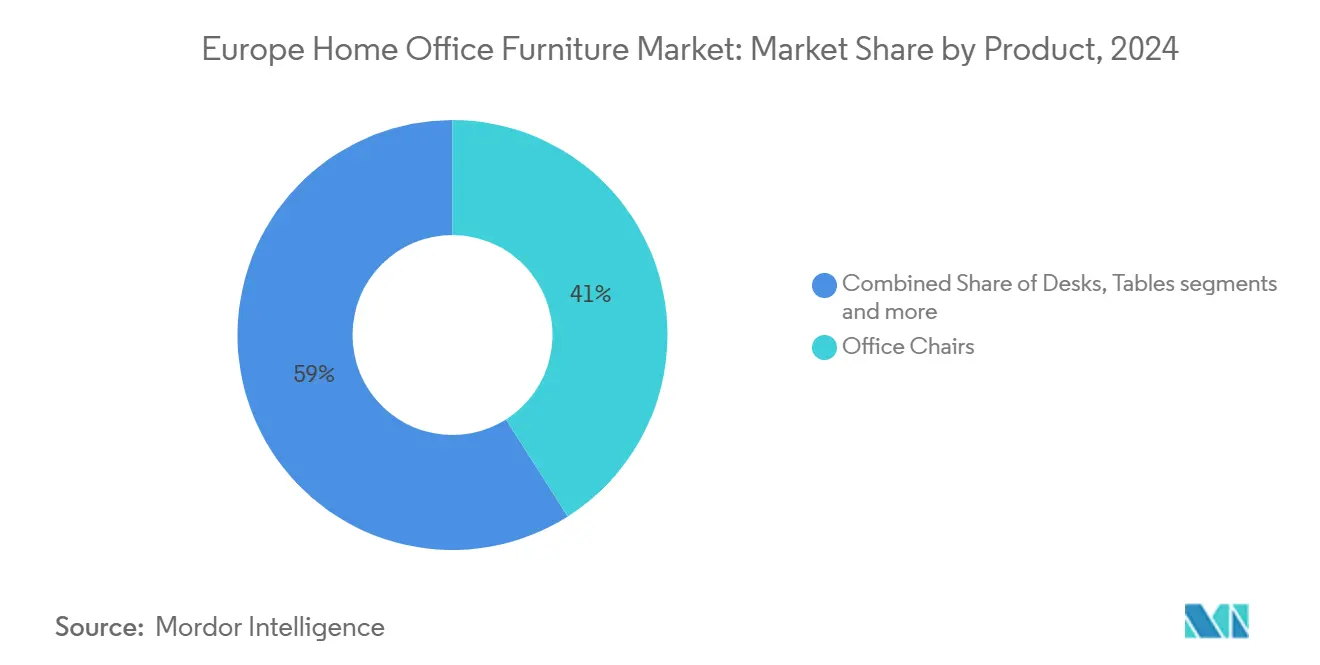
Note: Segment shares of all individual segments available upon report purchase
Material: Wood Maintains Dominance Amid Sustainability Push
Wood accounts for 45% Europe Home Office Furniture market share in 2024, retaining an aura of warmth and authenticity even as regulations tighten supply chains. Producers invest in digital lumber traceability and offcut optimization software to reduce waste and certify provenance, curbing cost escalation. Engineered panels, such as cross-laminated veneer boards, lighter than solid oak, meet structural demands while lowering shipping emissions, subtly increasing profit margins by shrinking freight charges.
Plastics and polymer composites are forecast to grow at a 5.5% CAGR because advances in recycled resins and bio-based polymers align durability with low environmental impact. Height-adjustable desk frames increasingly combine recycled steel columns with injection-molded recycled ABS cable covers to hit sustainability goals without driving up prices. Experimental materials—flax-fiber laminates, mycelium foams, and PET-felt acoustic panels—enter limited runs, granting pioneering brands a marketing edge. Metal remains irreplaceable for load-bearing frames, but aluminum alloys gain ground as their recyclability eases compliance with upcoming circular-economy directives.
Price Range: Mid-Range Dominates as Premium Accelerates
Mid-range items command 40% Europe Home Office Furniture market share, reflecting consumer preference for balanced value when outfitting a full workspace. Many mid-tier pieces borrow premium elements—soft-close drawers, adjustable arms—while using cost-optimized substrates hidden beneath veneer. Inflation has raised shopper price awareness, yet consistent quality remains non-negotiable, prompting brands to drop superficial embellishments in favor of structural reliability.
Premium goods will post the highest CAGR, at 5.2%, as high-income professionals treat home offices as long-term fixtures of career life. Superior ergonomics, connected features, and design pedigree justify higher ticket prices, and extended warranties further shift the conversation from cost to investment. Economy-tier sellers battle margin erosion by simplifying packaging and favoring flat-pack shipping, but they also risk losing share to certified pre-owned programs that now meet bargain hunters’ expectations for both price and sustainability.
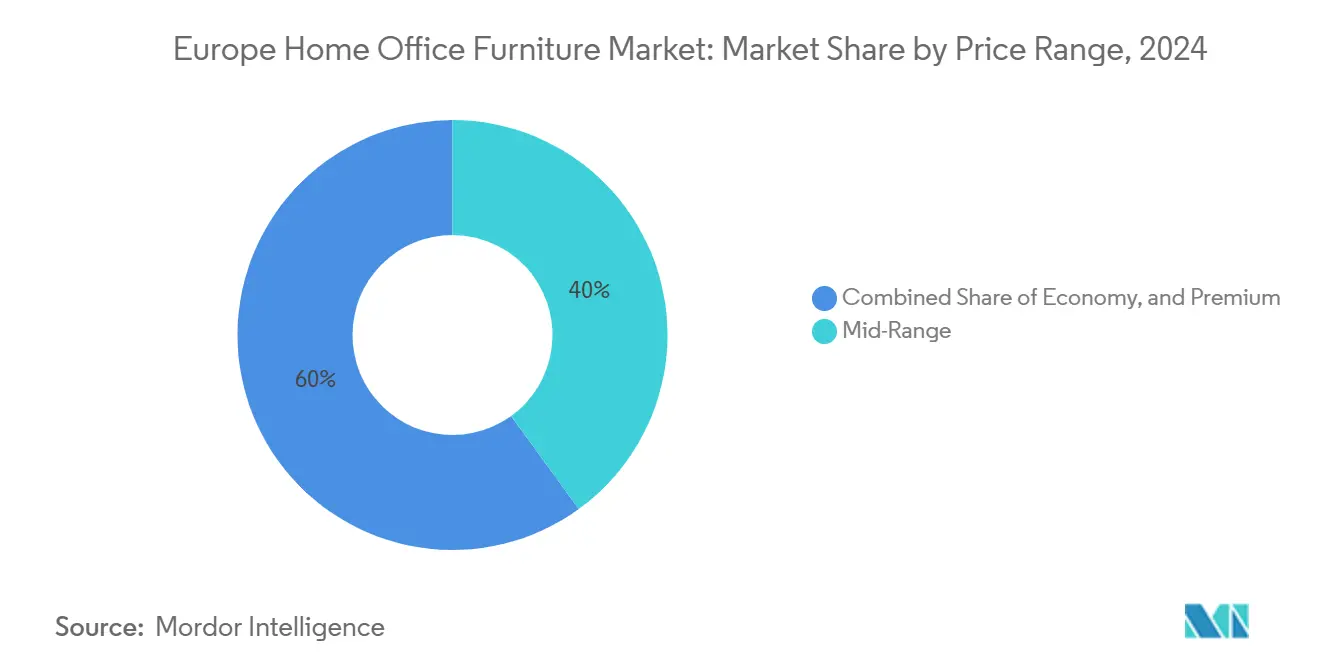
Note: Segment shares of all individual segments available upon report purchase
Distribution Channel: Specialty Stores Lead as Online Surges
Specialty stores hold 38% Europe Home Office Furniture market share and retain influence because shoppers value expert guidance on ergonomics. Retailers augment showrooms with 3D scanning booths that map a customer’s space, then render recommended setups, bridging tactile reassurance with digital convenience. These in-store services subtly stimulate higher-value purchases by visualizing upgrades on a real scale.
Online channels, growing at 7.3% CAGR, benefit from augmented-reality apps that superimpose true-to-life models into rooms, reducing return rates while boosting confidence. Home-center chains remain popular for urgent one-stop needs, especially when employers issue vouchers with tight redemption windows. Emerging micro-channels—pop-up galleries, direct-from-factory webshops and social-commerce streams—blur the traditional funnel, forcing manufacturers to align pricing across outlets to prevent conflict while preserving profitability.
Geography Analysis
Germany leads the region with 22% European Home Office Furniture market share, anchored by a strong manufacturing base, high disposable incomes, and a corporate culture that values ergonomic certification. Sustainability resonates deeply with German buyers, making FSC and PEFC labels decisive factors in brand selection. Domestic producers maintain prominence by combining engineering precision with eco-design, yet Eastern European suppliers intensify price competition in the mid-tier. Employers frequently subsidize home office equipment, smoothing demand even in slower macroeconomic periods.
Spain is set to post the highest growth rate at roughly 5% CAGR as delayed hybrid adoption now accelerates, aided by improving employment trends and rising digital literacy. Urban apartments in Madrid and Barcelona drive demand for slim, fold-away solutions that maximize utility per square meter. Spanish consumers exhibit a taste for Mediterranean aesthetics—earthy tones and natural finishes—which gives local designers an edge in the premium tier. E-commerce uptake is climbing quickly, closing the gap with northern Europe and expanding the addressable market for online-first brands.
France, though currently below the European average in remote-work penetration, offers significant headroom. French buyers prize design artistry on par with function, prompting suppliers to prioritize material texture and palette curation. Regulatory requirements for formal telework agreements create a steady pipeline of standardized demand as companies roll out stipend programs. Sustainability messaging gains traction in Paris and Lyon, where eco-labels complement the national preference for European-made products, challenging non-EU entrants to localize production or partner with established distributors. In the first quarter of 2024, nearly 75.7% of EU residents aged 20-64—around 197 million people—had a job, giving furniture makers a vast audience as hybrid work arrangements spread across the region.[3]Eurostat, “EU Labour Market - Quarterly Statistics,” Eurostat, ec.europa.eu Source: International Tropical Timber Organization, “Tropical Timber Market Report,” ITTO, itto.int
Competitive Landscape
Industry structure is moderately fragmented: global giants such as IKEA, Steelcase, and Herman Miller coexist with niche specialists offering acoustic or space-saving expertise. IKEA’s vertical integration lets it keep prices low while achieving near-universal FSC compliance, turning sustainability into a volume driver rather than a cost burden. The brand’s “pre-owned” initiative further captures secondary value and buffers the threat posed by independent recommerce platforms.
Premium leaders Steelcase and Herman Miller rely on long-standing ergonomic research and smart-chair patents, enabling cross-selling to employers who now co-finance home offices. Their integrated sensor suites deliver user analytics, strengthening aftermarket service revenues and reinforcing lock-in. Mid-sized innovators focus on localized sourcing and recycled materials—BuzziSpace uses PET-felt and recycled wool for acoustic panels, meeting strict Nordic Swan criteria and appealing to environmentally stringent Nordic markets.
Direct-to-consumer disruptors leverage lean supply chains and social-media storytelling to attract millennials craving transparent pricing. These players often arrange local micro-factories for just-in-time production, slashing inventory risk and delivering custom sizes within days. Partnerships with on-demand logistics firms reduce last-mile emissions and align with EU sustainability targets, creating yet another layer of differentiation within the Europe Home Office Furniture industry.
Europe Home Office Furniture Industry Leaders
-
IKEA
-
Actona Company A/S
-
Bisley
-
BoConcept
-
Poltrona Frau
- *Disclaimer: Major Players sorted in no particular order
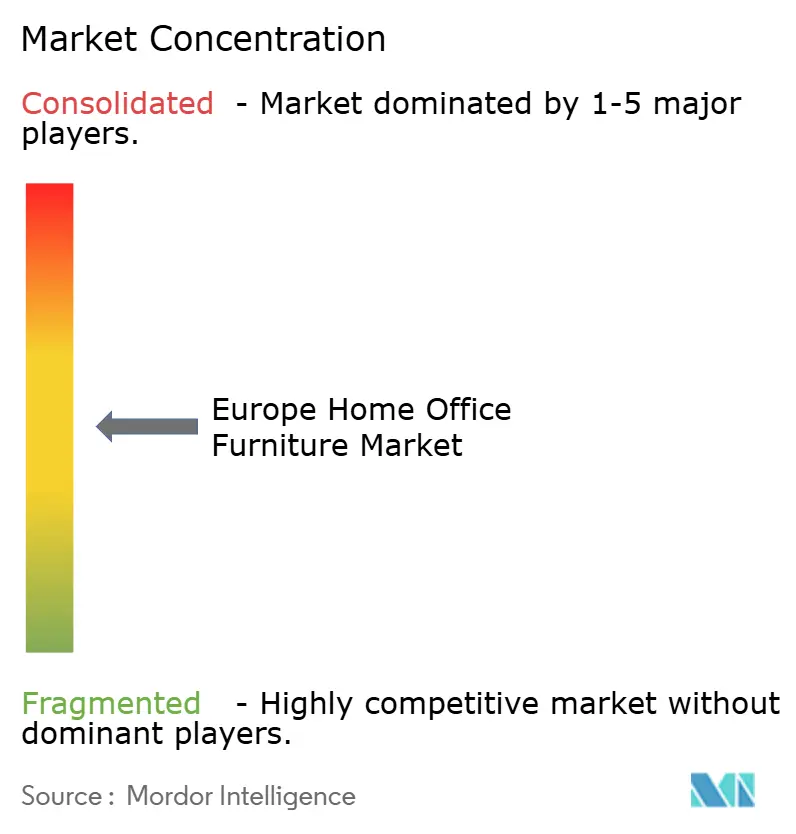
Recent Industry Developments
- August 2024: IKEA extended its “IKEA preowned” resale platform to more European countries, accelerating its circular-economy roadmap while reclaiming market share otherwise lost to third-party marketplaces.
- April 2024: Bentley Home debuted a customizable home office range at Milan Design Week, signaling luxury automotive brands’ expanding interest in premium furniture.
- March 2024: IKEA launched MITTZON, its largest office system to date, intended for both commercial and residential use, underscoring the blurring boundary between workplace and home.
- February 2024: Studio Elk introduced the minimalist Koru system, offering desks and chairs designed for easy repurposing across varied spaces and reinforcing consumer appetite for timeless aesthetics.
Research Methodology Framework and Report Scope
Market Definitions and Key Coverage
Our study defines the Europe home office furniture market as all purpose-built desks, chairs, tables, storage units, and related accessories that are sold for installation inside residential premises and used primarily to perform professional, academic, or entrepreneurial tasks from home. The pieces may be flat-packed or fully assembled and are valued at manufacturer selling price. We, the analysts at Mordor Intelligence, treat hybrid-work driven purchases made by employees, students, freelancers, and small-business owners alike as part of this demand pool.
Scope Exclusions: items procured in bulk for corporate offices, contract furniture for co-working hubs, and second-hand furniture sales are outside the study's scope.
Segmentation Overview
- By Product
- Office Chairs
- Desks
- Tables (side tables, printer tables, etc.)
- Storage Cabinets & Shelving
- Other Products (stools, bookcase, desk accessories, etc.)
- By Material
- Wood
- Metal
- Plastic & Polymer
- Other Materials
- By Price Range
- Economy
- Mid-Range
- Premium
- By Distribution Channel
- Home Centers
- Specialty Stores (including exclusive brand outlets)
- Online
- Other Distribution Channels
- By Geography
- United Kingdom
- Germany
- France
- Spain
- Italy
- BENELUX (Belgium, Netherlands, and Luxembourg)
- NORDICS (Denmark, Finland, Iceland, Norway, and Sweden)
- Rest of Europe
Detailed Research Methodology and Data Validation
Primary Research
Mordor analysts interviewed European furniture makers, big-box retailers, ergonomic consultants, and remote employees across Germany, the UK, Italy, and the Nordics. These discussions tested penetration assumptions, verified average selling prices for mid-range desks and task chairs, and clarified online channel growth rates, enabling us to refine segment shares and flag emerging materials (recyclable polymer blends).
Desk Research
We began by mapping the demand environment through public statistics, Eurostat's Household Budget Survey, EU Labor Force Survey telework penetration tables, and Eurofound's "Living, working and COVID-19" datasets, which quantify how many Europeans actually work from home. Trade flow and production value were gathered from UN Comtrade HS chapters 9401/9403, the European Federation of Furniture Manufacturers' annual factbook, and national furniture association dashboards such as Germany's VDM and the UK's BFM. Company filings, press releases captured via Dow Jones Factiva, and financial snapshots from D&B Hoovers completed the secondary picture. This list is illustrative; many other open and licensed sources fed our desk work.
Market-Sizing & Forecasting
We applied a top-down model that reconstructs demand from Eurostat production plus net imports, then apportions the flow to residential use via telework prevalence ratios and spend-per-worker coefficients. Select bottom-up checks, retailer revenue roll-ups and sampled ASP × unit sales, validate and fine-tune totals. Key variables include hybrid-work penetration, residential furniture expenditure per capita, e-commerce share of furniture sales, average unit price for ergonomic desks, and real disposable income growth. A multivariate regression links these indicators to historical market value and drives the 2025-2030 forecast, while scenario analysis captures interest-rate or housing-cycle shocks. Data gaps, particularly for smaller countries, are bridged with regional analogs and calibrated expert estimates.
Data Validation & Update Cycle
Outputs pass two-stage peer review, variance checks against independent benchmarks, and anomaly flags triggered by >5% deviations. Reports refresh each year; interim updates are released when material events, trade tariff shifts and labor law changes, alter baseline assumptions, and a final executive review occurs just before publication.
Why Mordor's Europe Home Office Furniture Baseline Commands Reliability
Published estimates often vary because firms select different base years, exclude online-only suppliers, or use unverified import mark-ups. Our disciplined scope alignment, annual refresh cadence, and dual-path modeling minimize these gaps.
Key Gap Drivers include whether gaming chairs are counted, how online cross-border sales are captured, and the exchange rates applied to non-euro countries. Our team's transparent variable set and telework-adjusted ratios keep the baseline grounded.
Benchmark comparison
| Market Size | Anonymized source | Primary gap driver |
|---|---|---|
| USD 6.28 B (2025) | Mordor Intelligence | - |
| USD 4.8 B (2024) | Regional Consultancy A | Excludes online pure-plays; assumes static telework levels |
| USD 4.6 B (2024) | Industry Journal B | Counts only wood furniture; omits polymer and metal units |
| USD 8.73 B (2024) | Global Consultancy C | Combines corporate and home segments; uses list prices without channel discounts |
The comparison shows that when scope alignment slips or price normalization is skipped, figures swing widely. Mordor Intelligence delivers a balanced, replicable baseline that decision-makers can trust for planning, benchmarking, and investment sizing.
Key Questions Answered in the Report
What is the forecast growth rate for the Europe Home Office Furniture market?
A compound annual growth rate of 4.20 % is projected between 2025 and 2030, driven mainly by hybrid-work adoption and sustained demand for ergonomic upgrades.
Which product category generates the largest revenue?
Office chairs hold the leading share, accounting for roughly two-fifths of total market revenue and delivering the strongest expansion among core segments.
How important is sustainability for European buyers of home office furniture?
Environmental credentials are now a baseline expectation, with FSC or PEFC certification frequently influencing brand choice, especially in Northern Europe.
Why are e-commerce sales growing faster than the total market?
Advanced 3D configurators and augmented-reality apps have removed visualization barriers, making online channels convenient for both research and purchase.
Which country shows the highest growth potential?
Spain currently posts the fastest growth outlook as hybrid work gains pace and digital retail penetration widens.
How are manufacturers addressing raw-material price volatility?
Suppliers diversify into recycled and composite materials, optimize design to reduce waste and secure local sourcing agreements to stabilize costs and supply chains.
What is the current size of the Europe home office furniture market?
The Europe home office furniture market size is valued USD 6.28 billion in 2025.
Page last updated on:
